Solar Water Heating
Wind Volt Technology | home
Solar Water Heating
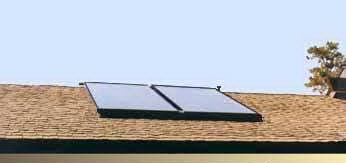
SOLAR ENERGY - IT PAYS OFF!
Nearly all forms of energy we use today to power commonplace vehicles and appliances is stored solar energy. Oil, gas, coal, wood and hydroelectric power simply wouldn't be here without the sun. If you give any thought at all to our future on this planet, squandering valuable resources like oil, gas and coal is downright foolish. In addition to polluting our air and
water these sources of energy are irreplaceable for the next few hundred million years.
Although solar space heating and hot water systems have a higher initial cost than conventional gas, oil or electric systems, they are the only systems that will pay you back. The dividend of energy savings has the added value of being untaxed. When the economics and environmental plus of solar equipment are totaled, the value of directly using the sun's energy becomes
clear.
SOLAR HEATING - A SIMPLE SOLUTION THAT CAN WORK FOR YOU
Take a black sheet of metal and put it in the sun. It becomes warm, at least warmer than any light colored object around it. Now put the sheet of metal in an insulated box with a sheet of glass facing the sun. The piece of metal will get hot, about 200°F. Tilt the box so the glass is directly facing the sun and the black sheet of metal will get even hotter, 250°+F. If you
now flow air or water over the black metal, you have a solar collector. The water or air is called a heat transfer fluid. Many gases and liquids can be used as a heat transfer fluid. They are necessary to move the solar produced heat from the collector to a building, tank or pool which you desire to heat. All other aspects of solar heating and hot water are merely refinements of this simple design.
Solar collectors work best in direct sunlight. A well made solar collector produces about half the heat in light cloudy weather as it does in full sunlight. So much solar energy is blocked by the dark rain clouds that solar collectors produce virtually nothing under these weather conditions.
All solar collectors, outside of the tropics, produce fifty to one hundred percent more heat in summer than in winter. The summer sun is much hotter because its high position in the sky at noon is closer to perpendicular to the earth's surface. The earth's atmosphere blocks a large part of solar energy and the summer sun goes through less of the atmosphere. The sun is at
its lowest point in the noon sky on the shortest day of the year, December 21st. or the winter solstice. Because of the extra atmosphere blocking the sunlight, solar collectors produce less heat. The colder outside temperatures also affect the collector production through heat lost through the collector back, front and sides.
We recommend that solar space and water heaters be tilted at an angle equal to your location's latitude plus 15° to optimize their production of heat in the winter. Swimming pool collectors for outside pools used in the spring, summer, and fall should be tilted at an angle equal to latitude minus 15° to optimize the seasonal sun. The sun is most intense at noon every day when it is highest in the sky. The four to five hours in late morning and early afternoon are called the "Solar Window". This is when more than 80% of the total collectable energy falls on a solar collector. Collectors should face as true south as possible towards the solar window. A variation of up to 30° east or west of true south is acceptable. If the collector(s) are faced more than 30° off true south more collectors will be required. If a choice of east or west is available it is usually best to orient the collectors to the west. The outside temperatures are almost always warmer in the afternoon. Prevailing local weather patterns should also be considered in mounting the collector. For instance, if you are in an area where mornings are normally clear and afternoons are cloudy, it would be best to face the collector in a more easterly direction. A properly orientated solar collector can increase system payback up to fifty percent quicker than a haphazardly installed system.
Type of Solar Water Heaters
Solar water heaters can be either active or passive. An active system uses an electric pump to circulate the fluid; a passive system has no pump. The amount of hot water a solar water heater produces depends on the type and size of the system, the amount of sun available at the site, proper installation, and the tilt angle and orientation of the collectors. Solar water heaters are also characterized as open loop (also called "direct") or closed loop (also called "indirect"). An open-loop system circulates household (potable) water through the collector. A closed-loop system uses a heat-transfer fluid (water or diluted antifreeze, for example) to collect heat and a heat exchanger to transfer the heat to the household water.
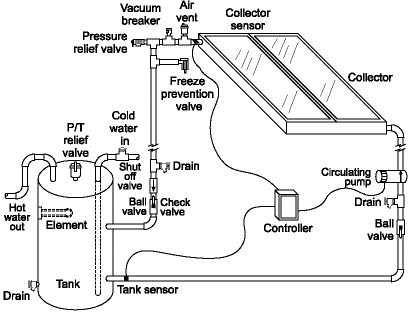
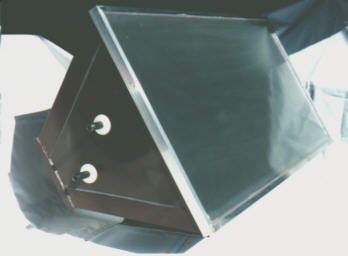
BATCH OR BREADBOX SOLAR WATER HEATERS
Batch water heaters are the simplest of all solar water heaters. These are also known as integral tank and collector heaters. Batch water heaters use tanks between 30 and 80 gallons. The tank is placed within a weatherproof, insulated enclosure with one side having a transparent or translucent glazing(s), normally two layers of glass. The side of the tank facing the glazing is painted black to absorb the solar energy which is conducted
directly to the water in the tank.
Batch solar water heaters work great in the tropics. Due to winter night time heat losses they function well in northern states as seasonal water pre-heaters. The only thing on one side of the collector between the hot tank and the cold outside air is 2 layers of glass. In climates harsher than this, the heater tends to lose at night most of the daytime energy gained throughout the winter months. Batch water heaters are simple, reliable, easy to install and are typically low cost. They can provide fifty to ninety percent of hot water needs depending on usage and climate. The piping to and from the heater is the weak link in the chain. It should be well insulated and heat tape should be installed in harsh climates.
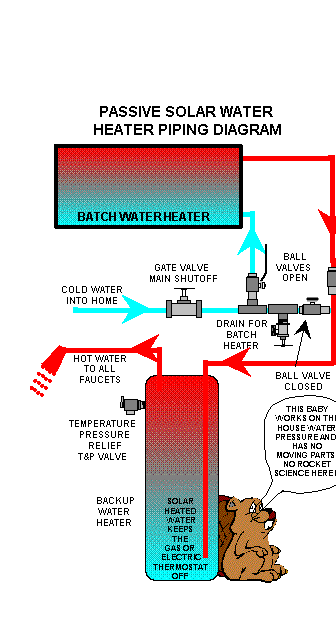
40 GALLON BATCH HEATER
TANK: Glass Lined
INSULATION: 2" Polyisocyanurate, Foil Faced.
CONSTRUCTION: Welded steel frame with brown baked enamel aluminum skin.
GLAZING: Two layers of textured, low iron tempered glass.
PLUMBING: Two 3/4" M.I.P. fittings.
DIMENSIONS: 36" X 78" X 26" Deep
DRY WEIGHT: 150 lbs.
FULL WEIGHT: 450 lbs.
FIVE YEAR LIMITED WARRANTY
40 Gallon
DIRECT PUMP SOLAR WATER HEATING
A direct pump system circulates tap water through the solar collector(s). These systems were first developed in the late 19th century and were in wide use up to the 1920’s in Southern California and Florida. The systems are called open loop and are very simple, efficient and reliable. A single low head (3' to 12') pump circulates the storage tank water through the solar collector. The water is piped from the bottom or coldest part of the tank to the pump, then to the collector and back to the top of the tank.
In alternating current (A.C. or house current) systems the pump is controlled by a differential control. The control constantly monitors the tank temperature and the collector temperature and turns the pump on when the collector is hotter than the tank
water. When the collector is no longer hotter than the tank the control shuts the pump off providing complete automatic operation.
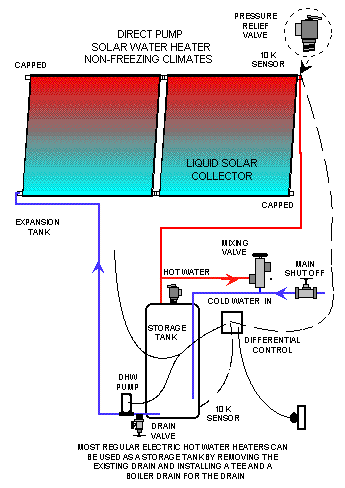
Direct current (D.C., usually provided by Photovoltaic systems) normally do not need a control if the pump, P.V. module and collector are properly sized. If there is enough sunlight for the P.V. module to run the pump then the collector should be hot enough to heat the tank water. When the sun goes down and the collector cools, the P.V. panel stops generating electricity to the pump.
Periodic maintenance is required if hard water with high mineral content is circulated through the collectors. If this is a possibility provisions should be made upon installation to be able to circulate a mild acidic solution (vinegar or intech 52) through the collector every three to five years to remove the mineral build up. Email us for prices
GLYCOL SYSTEMS
The majority of people in North America and the world live in climates where freezing temperatures are at least a possibility. Solar collectors are normally installed outside and copper tubes are subject to bursting when water freezes and expands. This alone makes untreated water unsuitable as a heat transfer fluid in solar collectors. Ethylene Glycol, Propylene Glycol, Silicone Fluid and a variety of oils have been used successfully in the past as heat transfer fluids. The lower specific heat (ability to hold heat) of silicone and bray oil and their limited availability and high price discourage wide usage today. Ethylene Glycol, better known as car antifreeze, is a good choice except for its toxicity. We prefer a fifty percent solution of non toxic propylene glycol and water as a heat transfer fluid in freezing climates.
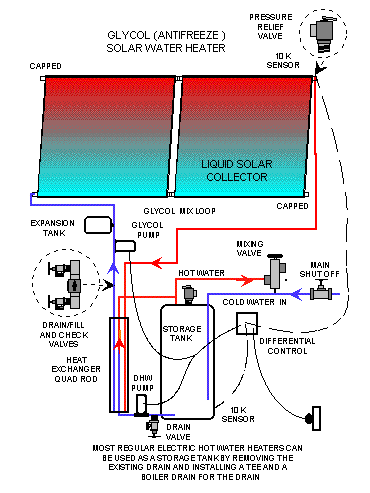
A glycol system contains two entirely separate piping systems which are called loops. The two piping systems or loops are connected through a device called a heat exchanger. A simple, economical heat exchanger can be constructed of a 1/2" copper pipe inside a 3/4" copper pipe. If the hot glycol solution is made to flow through the larger tube and cold water through the smaller, the heat will be exchanged and the water heated. This is called a single wall heat exchanger. Single wall heat exchangers are prohibited by the national plumbing code since breaching one pipe could possibly contaminate the domestic water loop if the glycol loop contained a toxic fluid. All glycol systems should have a design where two pipe walls must fail in order for the glycol loop fluid to mix with the potable (drinkable) water system. Although double wall heat exchangers are more complex and expensive, they should always be used in these systems.
A low head pump (3' to 12') is used to circulate the glycol solution. The water in the DHW (Domestic Hot Water) loop can be circulated through the heat exchanger with another low head pump or configured to thermosyphon. Thermosyphoning uses the physics that hotter liquids are lighter and will naturally rise. If the heat exchanger inlet connection can be placed and connected under or near the bottom of the storage tank and the outlet piped to the top of the tank the water will thermosyphon through the heat exchanger. The water will only flow if it is being heated by the glycol loop.
When any liquid is heated it expands physically. In open loop systems this expansion is not a problem since the extra pressure is absorbed through the entire piping system in the house, well system or city water system. The glycol loop is closed and an expansion tank of the proper size is required to prevent excessive pressure in the loop.
A differential control is needed if two pumps are used in the glycol system. If the system can be installed with a thermosyphon DHW loop a simple snap disc switch or light sensing switch will normally be workable. If P.V., D.C. power is used with a D.C. pump(s) and the components are sized correctly a control is usually not necessary.
Periodic maintenance of glycol systems must address two things, the condition of the glycol and the hardness of the domestic water. Glycol solutions can turn acidic after a few years of use. The solution should be checked with Litmus paper or a P.H. meter every three to five years. Acidic glycol solutions should be drained, purged with water and refilled with a new solution. Acidic solutions are usually caused by overheating the glycol loop above 225°F. If the solar system is not used for an extended period of time, the collector loop should be drained and the fluid stored or the collector glazing should be covered. If hard water with high mineral content is circulated through the DHW loop, the tubes in the heat exchanger will eventually clog. This should be checked every three to five years depending on water hardness and corrected with a light acidic solution (vinegar or intech 52) circulated through the tubes until the deposits are gone. A heat exchanger that can be taken apart can be cleaned with a wire brush. A correctly designed solar water heater of this type can produce hot water in virtually any climate for decades. Email us for prices
SOLAR PANEL (COLLECTORS) AND MOUNTING:
______ 1. Collectors face as close to true south as possible with no more than a 90º variance.
______ 2. Proper tilt angle for purpose.
______ 3. Receive reasonably unobstructed sunlight or surface area has been increased accordingly.
______ 4. Collectors and roof are ice and snow protected.
______ 5. Space is available for inspection and service.
______ 6. Weep holes are properly located.
______ 7. Collectors are rodent protected.
______ 8. Water-flow to and from gutters is unobstructed.
______ 9. Glazing is not cracked.
______ 10. Freeze sensor is well protected and secured.
______ 11. Mounting hardware is well protected.
______ 12. Dissimilar metals do not touch.
______ 13. All penetrations are adequately sealed and flashed.
______ 14. All exposed wood is treated.
______ 15. Bolt and screw holes are sealed.
SPANNERS (STRINGERS):
______ 16. Mounting holes are 3/8" diameter or greater.
______ 17. Neoprene washers installed.
______ 18. All penetrations sealed.
LAG BOLT MOUNTS:
______ 19. Bolts are 3/8" diameter or greater.
______ 20. Bolts penetrate rafters.
______ 21. All penetrations sealed.
______ 22. Neoprene washers installed.
RACKS:
______ 23. Will withstand 100 MPH winds.
______ 24. Properly flashed.
GROUND MOUNTS:
______ 25. Bottom of collector is 2 feet above ground.
______ 26. Footings extend below frost line.
PLUMBING:
______ 1. Proper valves are used throughout the system.
______ 2. Backflow preventer on potable water supply when necessary.
______ 3. No direct connection between potable line and waste line.
______ 4. Double-walled heat exchanger if toxic anti-freeze is used.
______ 5. Necessary Valves and pipes clearly labeled.
VALVES:
______ 6. System fully protected against excess pressure and temperature.
______ 7. Pressure relief valves properly installed and piped to drains.
______ 8. Vacuum breakers properly installed.
______ 9. Expansion tank and pressure gauge properly installed.
______ 10. Tempering valve set at 140°F and properly installed on hot water supply line.
______ 11. Check valve installed on cold water supply to tempering valve line.
______ 12. Air vents (coin/float) installed at all high points in system.
PIPING:
______ 13. No air traps in pipe run.
______ 14. Pipes are properly vented.
______ 15. Expansion joints used if necessary.
______ 16. All threaded joints are Teflon taped.
______ 17. All sweated joints are properly soldered.
______ 18. All pipes adequately supported.
______ 19. Joints around the collector soldered with 95/5 solder.
INSULATION:
______ 1. Properly installed ....after leak testing.
______ 2. Outside insulation waterproof and UV protected.
______ 3. Storage tank insulated.
______ 4. Insulation not impeding any part of system.
______ 5. Pumps, valves, and vents not insulated.
______ 6. Hangers not affecting insulation.
ELECTRICAL:
______ 1. Proper sensors installed securely.
______ 2. Sensors protected from ambient air.
______ 3. All wire splices secure and capped.
______ 4. Outdoor wiring is used where needed.
______ 5. Power input grounded and protected.
______ 6. Proper safety precautions practiced at all times.
GENERAL:
______ 1. System filled and pressurized to proper pressure.
______ 2. All work done neatly, carefully, and professionally.